Review GSM phone Sony Ericsson K600
Sony Ericsson K600. Live pictures
Standard kit:
- Handset
- Charger
- Manual
- USB-cable
- CD with software
3G networks get prior for all the manufacturers; we now see a tendency of double standard phones replacing usual ones. Many manufacturers posed an ambitious problem of gaining great parts of the UMTS-terminals market in 2005. Thus the market enters the adult stage after the first timid experiments. This increase of the game players' number will cause the fall of the price of the 3G phone for an ultimate consumer, and that will add to the attraction of the devices more. At the moment Motorola gained quite serious positions on the 3G market with its highly demanded products released with a fairly good periodicity. Sony Ericsson decided on challenging its leadership and introduced the K600. The device is positioned as a mass 3G solution, it small size and use simplicity. The company presents the K600's size as an advantage of the device, though this generation devices will be comparable to the K600 in size. Not so many models are launched in a classic form-factor for 3G networks, and these are mainly Motorola's products. The latter prefers not to miniaturize its phones making their size somehow in the middle between usual phones and smartphones. And that is what Sony Ericsson figures on, the idea is to offer a phone of a not spread form-factor (though dominating on the GSM market) and decrease its size. The attraction of the device is evident if it provides with a standard functionality and an adequate price.

The model resembles a metallic one, that is a popular design today. In fact, the panels are of plastic though making a feeling of being metallic. You can make certain it their simplicity by looking at the back panel. The size of the device is quite comfortable (104.3x45x19.2 mm), and as we have already said practically there are no differences from a usual phone. The device might be thick a little, but you won't notice that in everyday life. The thickness of a body is a very relative concept that should be first considered as a derivation of two other dimensions (length and height). In our case, the device is comfortable to hold and lies well in a hand. Speaking about the target group of the model is rather thankless, since the device will look well both in a man's and a woman's hand. On the other hand, primary users of 3G networks are men and thus the body colour is only one. In general, that is typical of Sony Ericsson to use only one colour and then release an operator version in another colour. I won't be surprised, if the K600 will be released in a really suiting black body colour for Vodafone. The weight of the phone is comfortable and resembles the first 3G phones in nothing (105 grams).



The buttons placed on the side body slants came from the models for the Japanese market. One of them is responsible for activating videocall and another one traditionally calls a web-browser. Their presence doesn't mean there are no side buttons, and thus volume buttons are separated and placed on the right-side surface. Their unusual disposition is caused by the phone having the second constituent - working in a camera mode, and then the buttons are needed on the top. And a camera button is placed on the same surface being displaced down.

There is a VGA-camera gap to the right of a loudspeaker grate, it serves for videocalls, it can't be used for taking photos and that is quite logical considering the presence of a 1.3 MP camera. At the same time it is possible to switch to the main camera in the videocall mode, and then the phone is better to turn horizontally. The loudspeaker grate is displaced to the left a bit because of the camera disposition and that can make problems with the sound quality at first sight. Materially, there are none of them, you need no extra positioning of the phone, everything is natural and calm.
The screen has the resolution of 176x220 pixels (28x36 mm) showing up to 262K (TFT). Physically, its matrix has no differences from the previous models, and the increased number of shown colour is caused by using another controller. You won't see any principal difference between 65K and 262K in the screen, though it is qualitative, the picture is good, vivid and the interface drawing is very pleasant. Te display gives way to Samsung and Sharp models in the picture brightness, and in general more belongs to their group rather than to the middle-class. No cavils to the screen may appear in its class, and moreover, it is obviously one of the best in this form-factor. The picture fades in the sun, but text remains readable. To tell the truth, small font-size prevents from seeing all the necessary details sometimes (this doesn't concern SMS and names in a phonebook, here everything is all right).



The joystick is of metal without any silicone cover thus making an illusory feeling of discomfort. And for those who got used to acquaint with the device for only one-two minutes it will really be uncomfortable. The main secret is plain - press it a little while working with the joystick. The joystick motion is rather soft; it is comfortable in a permanent work. The device is mainly for right-handed people since working with the joystick using your left hand is not as comfortable.
The keypad is of plastic and the buttons are a bit smaller than average and deeply sunk into the body. When working with the keypad you unwillingly touch the body, but that makes no discomfort considering the softness of the pressure. The keypad is average in comfort; the ergonomics is acceptable, though not distinguishing in anything special. The backlighting is blue, not very bright and well seen in the dark. The characters are large and seen well on the buttons.
There is a standard interface connector on the bottom end; it is compatible with other models and allows using the whole accessory line with the K600. And a strap hole is also here.
An On/Off button is on the top of the phone and service indicator with the minimum possible surface area is near it. The device is equipped with a miniUSB plug-and-socket that allows connecting to a PC. The old interface connector supports no fast data transmission and thus an extra one is necessary. The following models come equipped with a Fast Port connector and not a miniUSB one. I won't judge how well-taken the use of own connector instead of integrating a miniUSB one is, it is most likely caused by the wish to make company accessories more sold that is easy to explain.

There is a 1.3 MP camera objective closed with a sliding shutter on the back of the device. Opening the shutter activates the camera in the last chosen mode automatically. And a "flash" is also here.



There are two sliders on the left-side surface; sliding them you open the back cover. It hides a 900 mAh Li-Ion battery (BST-37). According to the manufacturer, it is capable of working for up to 200 hours in the standby mode and up to 6 hours of talks. In Moscow the device averagely worked for about 3 days in case of one hour of talks, up to 45 minutes of using other functions and two hours' listening to the radio a day. If working less with the phone, it will work about 4-4.5 days. Full recharging takes about 2 hours.



Menu
As for the menu organization, it is a typical last generation model by Sony Ericsson without any interface changes already applied in the K700. You may assign tags or fast call of this or that function to the joystick deviations. The main menu is represented with four rows with three icons in each. You also may use fast navigation with the number series, and then switching to a necessary item will take some seconds.


The input convenience remained on the same level, by pressing the # key you will bring up available language list, and be able to switch between them while text input.
The manufacturer decided to take care of additional horizontal theme bookmarks. This means that now when you are in the call list menu, which is called by pressing the Call button, you will see not only the last dialed numbers but gain the ability to switch between bookmarks with last missed/received calls (horizontal joystick presses). In the phone's menu such navigation is used in all possible places, it strongly simplifies usage of phone; menu's ergonomics in this model is extremely high. I'd like to point out those similar horizontal panels present in the phone book, settings menu and several other menu items as well.
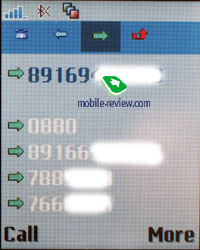
The model is mainly a copy of the K700 with different menu representation, new themes, more phone book entries possible, but the base is the same.
Phone book. As different to the previous models up to 510 names with all the fields filled in are supported. Summing up, we get more than 2000 numbers that are more than enough for the majority of users. And a poll carried out on our site proves the same.
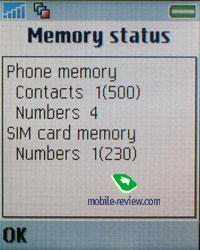
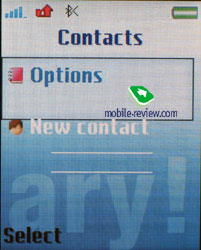
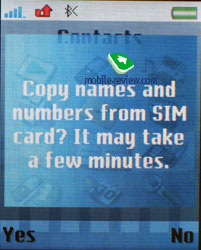
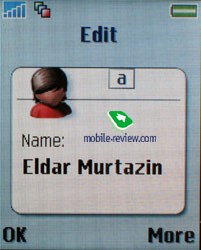
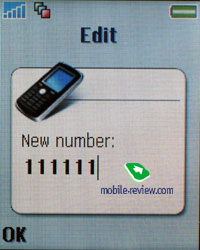
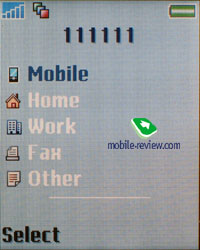
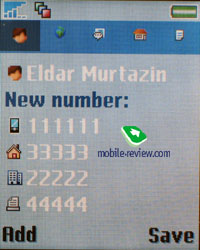
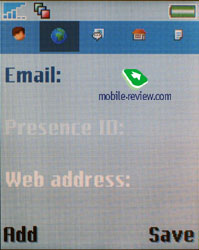
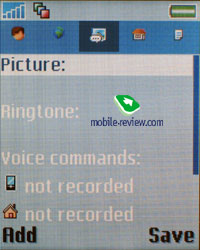
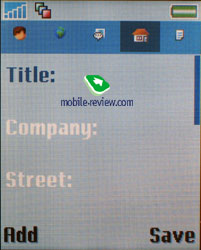
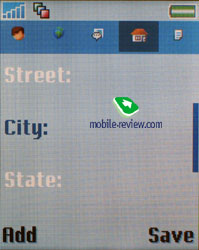
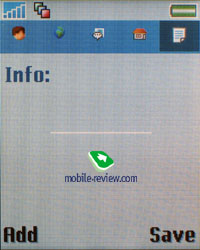
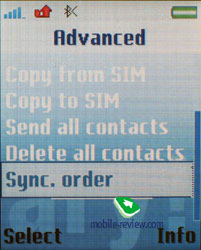

Several phone numbers, e-mail address and other contact information may be kept for a name in the internal memory. In settings you can choose the required fields, as well as sorting by various fields including name, surname, but the input field remains single. Such sorting is important only while transferring data from PC, for phone's entries it's actually useless. For separate names you can setup custom ring tones and own picture, while the incoming call you will hear the custom ring tone, as well as chosen image.
While information input you are free to scroll between bookmarks, on the first one phone number entering and their sorting according to types. Actually this organization reminds Outlook for some reason, it is convenient. Ability to add voice dialing to separate numbers stored under one name was introduced as well, there can be up to 40 of them in total. If you remember, earlier on voice dialing was supported only for names, and you had to make additional voice dialing bookmarks for other phones stored under the same contact.
While viewing the phone book you can scroll the numbers by the horizontal joystick's keypress, as well as watching other information. Of course the default number will be bind by you.
Traditionally the company believes that SIM-card and its memory will be used only in emergency situations, and not for storing information continuously. Viewing the entries on the SIM-card is possible from the separate menu item; they are not displayed in the common entry list.
Messages. All functions are basic for messages; templates and ability to create your own ones are present. For messages storing phone's memory as well as SIM-card's is used. Chat function is supported, on the whole I can say that the features are pretty common for any other phone. Appeared emoticons should be mentioned as well, they are made on a new quality level, and support youth part of the phone.
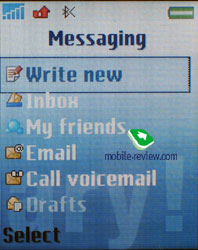

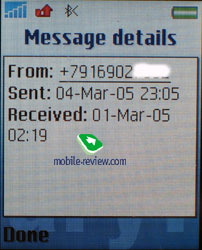
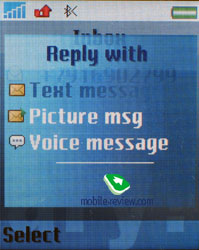
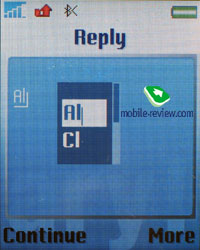
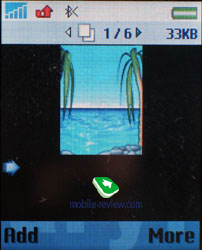
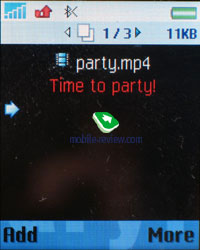

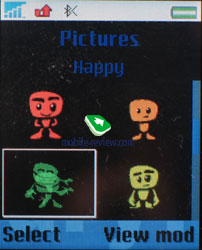
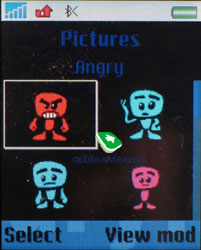

E-Mail client supports sending and receiving messages, all possible encodings are supported.
In this menu Instant Messaging is present as well, sort of ICQ analogue.
Call list. In common list you will see up to 30 entries with date and time assigned to each. Near each of them an icon will explain to what type of call it refers (missed, received, dialed). Besides this in common list additional icons are present, they show if the phone number is present in the phone's memory, or SIM-card's. The list of missed calls can be viewed separately; it can store up to 10 entries. In the same menu item information about cost and length of last, all calls can be viewed. Moving through the separate lists can be made with the help of bookmarks; this actually saves your time greatly.
Entertainment. This menu item contains access to picture album, list of music files. Function MuiscDJ is interesting, although it is rather niche and will not be in demand around most of users. In this editor you can create your own ring tones and edit up to 4 tracks.

VideoDJ is an advances version of a MusicDJ function. It allows editing not just music, but adding pictures, notes and the result is a 3GP file possible to send via MMS or E-mail or just sent to another phone.
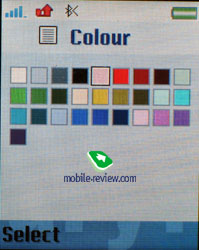
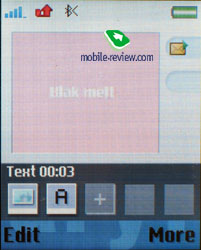
A graphical editor for drawing simple pictures is for creative people. Sometimes it helps to while away the time, though mainly the function is unnecessary.


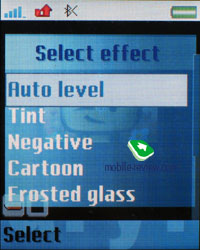
Organizer. In organizer menu a lot of functions are stored at once, first of all - let's review the calendar. There are three types of event view, monthly, weekly and daily. In last case you see the list of all things to do and reminders, in two other modes you will notice the highlighted time with events or the day. Fast transfer to the required year, day and month is present. Everything is pretty simple and traditional, as well as schedule entry. Basically you get the chance to choose one of the 6 icons assigned to the action type, specify the place where it will occur, length and setup reminder (beforehand or in the entered time). I was unable find a way to setup reoccurrence rate; in my samples this feature was not present at all. From the editing menu for separate events you can choose another time and date, and that's it. Reminders work even if the phone is turned off, in case you turn on this function in the settings menu. Pleasant peculiarity of this model is that you can turn on/off automatic switch of profiles after the event had occurred, as well as return to the earlier set profile after the event is over. Basically we get analogue of Time Profile function in Nokia's phones.
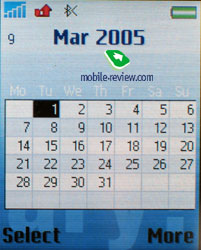 
 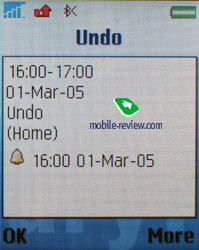
To do list of rather ascetic, only two modes of events, call or reminder. On the other hand this is pretty enough, simplicity has its own advantages as well.
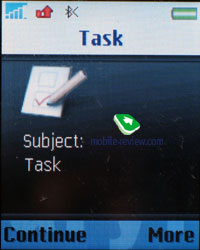 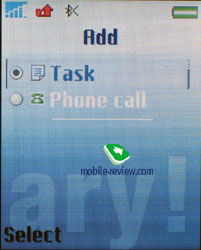
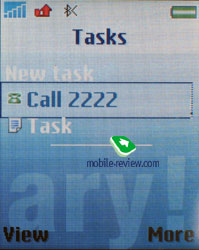 
The phone has fully-functional search, which is organized for calendar, you just enter the words (or part of it) and after few seconds see all events which suit for the searched words. Function works very fast even if there are more than 100 entries, fast teleportation to the event is supported as well.
The phone has normal support of sending files to different devices (like always - IrDA, Bluetooth). You just choose the required interval (day, week, or month) and send all entries. I'd like to point out the fact that receiving device must support PIM function in order to receive and display these data files correctly. When we tried to send our own schedule to TV-set it was successful, although it could not be displayed (via IrDA). Same thing can be sent from your office or desktop PC without any additional software for synchronization.
Notes. The phone supports recording short text notes; in common list first word from each is displayed. This is not always convenient since you have to enter every note with "marker word", in order to remember what it is all about.
 
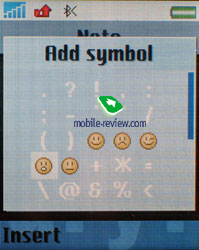 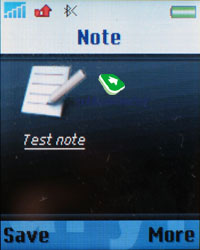
Alarm clocks. The phone has single as well as reoccurring alarm clock, which can be setup by the defined days of week. The alarm clocks will work even if the phone is turned off.

Countdown timer. Everything is pretty simple here, although same thing can be said about the stop-watch, it supports intervals. The phone has code storage, which was loved by many, calculator is typical.
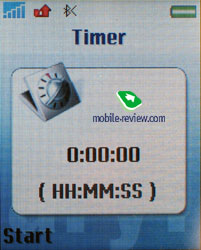 
 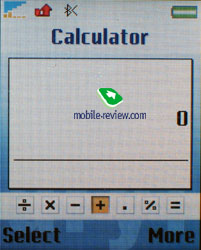

Connectivity. From here you can setup all communication settings of the phone starting with WAP, GPRS and ending with synchronization. The standard usage will not be mentioned, it is pretty obvious, everything works. I'd like to stress that no problems were encountered while synchronizing; synchronization with devices runs smoothly, all profiles are supported.
The same menu provides local and remote localization settings, everything is also standard. The device supports the HID profile that allows using it as a remote controller for a computer or other device.
The following Bluetooth profiles are supported:
- Dial-up networking profile
- Generic Access profile
- Generic Object Exchange Profile
- Object Push Profile
- Serial Port Profile
- Handsfree Profile
- Headset Profile
- Synchronization Profile
- Basic Imaging Profile
- File Transfer Profile
- HID Profile
- SyncML OBEX binding
- JSR-82 Java API
WAP. The browser was given separate menu item's sport, its version is 2.0 and it supports secured transfers, which is important for electronic transactions. With the help of browser you can download new wallpapers, themes, ring tones, everything is available on the original web-site.

Settings. Basically all settings related to the work with the phone are stored here, partly with the appearance of screens. I will not describe this menu item, since everything is too common. The presence of updated themes should be mentioned though, they actually differ the appearance nicely.
 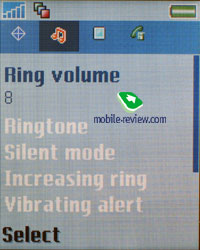
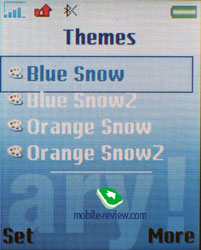 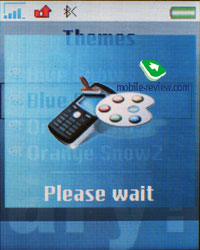
Radio. The phone has a built-in FM tuner; it is different from other versions in RDS support that is a creeping line with information transmitted by the radio station, a copy of the same function in car radio player. The phone's memory can store up to 20 radio stations; the stereo headset that is shipped in every package plays the role of antenna. In case you are using auto-search the phone will find about 6-7 stations with the strongest signal's coverage (at least it did it in Moscow) and store them in the memory. At the same time radio stations with weaker signal, but pretty suitable for listening will be skipped. They can be added into the list manually. This parameter is identical to Nokia phones, in which same problems are noticed.
Signal's playback quality is rather high, the headset allows setting up almost any volume, maximal level is extremely loud, and the music will suppress everything. The user can switch the radio into the loudspeaker mode; in this case people around will hear it as well. The radio's volume is pretty high.
Unfortunately, all control is made from the phone's keyboard. Channel switch which are stored in the memory - joystick's vertical movement. You can regulate the volume with the help of side-buttons. In case you want to turn off the radio and move on to other menu item's functions you will have to minimize it the way you are doing it on your desktop PC. In order to have the ability of changing channels again you will have to call Radio mode again. In minimized condition appropriate icon will appear.
Brief impressions from the radio can be described as positive, this phone's parameter is interesting, more than that, it offers quality realization. The radio is not worse than in Nokia's products and this speaks out for a lot of things, as well as the fact that the radio works in stereo mode.
File manager, amount of memory. The user can have about 38 Mb of free space, on which his data, files (pictures, video clips, and applications) can be stored. Remaining memory is occupied with pre-installed applications, which you cannot delete. Part of phone's memory is used as phonebook, call list etc. There is no much but enough free space for keeping personal photos taken with the megapixel camera due to the absence of a memory card. Considering the easiness of copying data to a PC, it can't be taken as a serious disadvantage, though the restriction exists and should be taken into consideration if photo component is important to you.
The phone also gained simple file manager, with its help you can sort files into various folders, create directories in the phone's memory and store files in them. Using internal memory for file storage is impossible; the phone declined storing files with unknown extensions. But if you rename the file (its extension) it will be easily stored in the phone's memory. Meanwhile when we tried to view it, it lead to error; however the phone did not freeze and continued working. In future you will be able to send files via IrDA and Bluetooth in near future. Basically we face the fact that the phone can be used as file storage for very important files.

Player. The phone has built-in mp3 file player, as well as 3GP. The player is actually a nice tool for listening to mp3 files, the phone can be used for file storage, you can store one or two songs in very good quality. This is the only term of using the player, it can not be used as alternative to mp3 player.
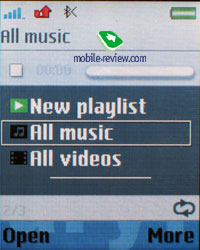 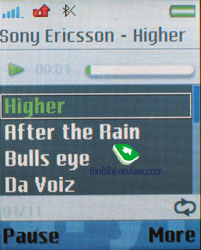
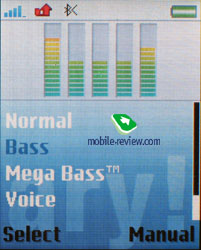 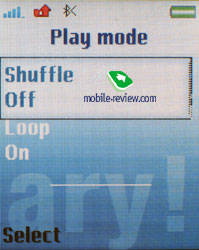
Equalizer setup is present among the other settings (Bass, Voice, Tremble etc), as well as the ability of creating your own settings. Depending on these settings the sound will actually change, this is noticeable.
Camera. A 1.3 MP camera is integrated into the phone; in difference to Sony Ericsson S700 the matrix is CMOS that worsens the picture quality even in a sunny day. Noises are clearly seen on indoors photos, especially when lacking lights. The flash is optional and making no any influence on the quality of the photos.
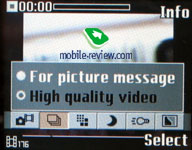 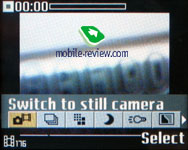
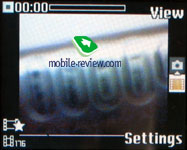 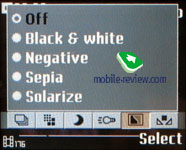
 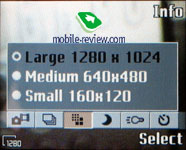
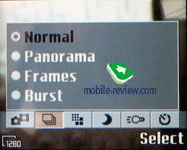 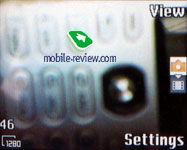
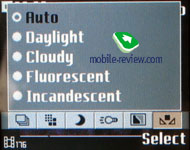 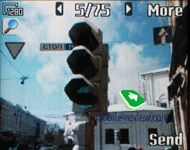
Three possible resolutions are supported - 1280x1024, 640x480, 160x120 pixels. There is no a possibility to choose a compression level, the photos are always of the highest quality.
The camera settings look the following way:
Automatic camera off. When not used the camera turns off automatically in 30 seconds, 1, 2 or 3 minutes.
Shutter sound. You can choose on of the three shutter sounds but not turn the sound off.
Spot photometry. The function is unusual for a mobile phone.
White balance. A possibility to choose between an automatic mode or Incandescent, Fluorescent, Daylight, Cloudy.
Light. Backlighting activation, also may be turned on by shifting a left-side cover.
Effects. Several effects may be applied to the photos, they are Negative, Solarize, Sepia, Black & White.
Timer is activated for a certain time period for self shooting.
Night mode is for shooting in the dark. Noises raise on a photo, exposition is increased (you shouldn't move the device in order not to get a blurry photo).
Shooting mode. Normal mode, that is taking usual photos. A multiple mode (Burst 4) allows taking four photos for a series. The last mode is taking photos with frames; there are 14 of them in the phone.
Let's acquaint with various photos taken in various conditions. Let's start with the bets photos taken in the street.
Sample
photo outdoors, Luzhniki, 1280x1024, 261 KB, JPEG
Sample
photo outdoors, Ramstore, 1280x1024, 259 KB, JPEG
Sample
photo outdoors, Lukoil, 1280x1024, 235 KB, JPEG
Sample
photo outdoors, Lukoil, 1280x1024, 246 KB, JPEG
Sample
photo outdoors, traffic lights, 1280x1024, 257 KB, JPEG
Sample
photo outdoors, street, 1280x1024, 278 KB, JPEG
Sample
photo outdoors, church, 1280x1024, 272 KB, JPEG
Sample
photo outdoors, church, 1280x1024, 295 KB, JPEG
Sample
photo outdoors, church, 1280x1024, 264 KB, JPEG
Sample
photo outdoors, a church store, 1280x1024, 265 KB,
JPEG
Sample
photo outdoors, magazines at a stand, 1280x1024, 250 KB, JPEG
Sample
photo outdoors, a trolley bus, 1280x1024, 239 KB, JPEG
Sample
photo outdoors, icicles, 1280x1024, 238 KB, JPEG
Sample
photo outdoors, traffic wardents, 1280x1024, 252 KB, JPEG
Sample
photo outdoors, text at a post office, 1280x1024, 245 KB, JPEG
And here is an indoors photo - 1280x1024, 000 KB,
JPEG
The same photo
with exposition corrected from – 6 to +6. Photos in a ZIP-archive,
807 KB>>>
See effects in another archive, ZIP, 268 KB >>>
The frames are various and known by other models. In principle, you can apply a frame in the graphical editor, and here the function is for lazy ones.

Landscape mode is very interesting; you can reveal creative skills here.
Sample
landscape №1, JPEG, 1664x432 pixels, 134 KB
Sample
landscape №2 JPEG, 1664x432 pixels, 145 KB
Sample
landscape №3 JPEG, 1664x432 pixels, 44.5 KB
Noises get noticeable indoors; they are high even in good lights.
Sample
photo indoors, the floor, 1280x1024, 320 KB, JPEG
Sample
photo indoors, flavours on the table, 1280x1024, 297 KB, JPEG
Sample
photo indoors, flavours, 1280x1024, 141 KB, JPEG
In a dark room the noises get unacceptable, and the picture quality decreases greatly.
Sample
photo indoors, a printed babbit, 1280x1024, 336 KB, JPEG
Sample
photo indoors, a monitor, 1280x1024, 291 KB, JPEG
Sample
photo indoors, phones on the table, 1280x1024, 275 KB, JPEG
Sample
photo indoors, phones on the table and a shit of papaer, 1280x1024,
297 KB, JPEG
Sample
photo indoors, napkins, a photo with a flash, 1280x1024, 287
KB, JPEG
Sample
photo indoors, a mulled wine note, with a flash, 1280x1024,
311 KB, JPEG
We'll provide two photos taken by the S700 and the K600 to compare.
A photo with
S700, K600
A photo with
S700, K600
Video may be recorded in two resolutions (176x144, 128x96), file format is 3GP. Clip duration may be limited (up to 10 seconds) or unlimited. The quality of the clips is average and E720/E730, for instance, make more qualitative records, the same may be told about Sagem myX-8.
Sample
video (3GP, 171 KB)
Sample
video (3GP, 211 KB)
Sample
video (3GP, 209 KB)
Sample
video (3GP, 336 KB)
A short summary of the camera is the following. There are no evident problems, outdoors the camera corresponds with a medium level and is typical for modern devices. Low resolution for video may be considered a minus. Such cameras get mass for the company, that is a standard solution.
Java. The phone supports Java (MIDP 2.0), as well as 3D-engine, which allows launching truly three-dimensional games (not only Mascot Capsule is supported but JSR-184 also). Some games already known by other models of the company are preinstalled.

Productivity. We used JBenchmark to measure the device's productivity, and its supporting 3D Java allowed launching a corresponding test.
It gave the following results:
JBenchmark 3D
HQ 90
LQ 128
Triangles ps 13876
KTexels ps 703
3.0.2 version
176x220
M3G Version 1.0
Antialiasing false
True color false
Dithering false
Mipmapping true
Perspective correction true
Local camera lighting false
Max lights 8
Max viewport dimensions 1024
Max texture dimensions 256
Max Sprite Crop Dimensions 1024
Max Transforms Per Vertex 3
Number of Texture Units 2
Other properties
Color Screen true
Number of colors 65536
Transparency (alpha level) 256
Double buffer true
Total memory 524284
Free memory 422160
Comparing the results with Sony Ericsson Z800 we see they are almost the same. That is a typical for today phones productivity level. Only Motorola E1000 is inferior to Sony Ericsson's phones in operating speed. For instance, Siemens 65-series phones have greater performance - about 120 points in average. We do not compare productivity with smartphones, since they will no doubt exceed usual phones.
This rather low score is caused by a relatively "row" 3D Java in the model, the company integrated the standard to compete with other manufacturers. The main emphasis of the model is put on Mascot Capsule Engine providing high operating speed and being less resource demanding. Unfortunately, we failed in finding games for 3D Java similar to the preinstalled ones, but subjectively, Mascot Capsule's productivity is much higher.
The second version of the test package gave the following results:
Jbenchmark 2 255
Details
Image manipulation 175
Text 679
Sprites 261
3d Transform 224
User Interface 153
2.0.4
176x176
True 65536
MicroEdition Platform SonyEricsson K600/R2B008
The result is very high and quite comparable with smartphones' operating speed, for instance, the last generation model Nokia 6630 (the bets score was 246).
A complete version of the package showed the following results:
JBenchmark 1 2342
Details
Text 641
2D Shapes 577
3D Shapes 365
Fill Rate 279
Animation 480
1.0.4
The productivity is also very high and close to the maximum. Indeed, as for the Java virtual machine speed the phone is one of the strongest in its class, even comparable with smartphones.
Impressions
The device has no problems with he connection quality being a typical phone by the company and very reliable in this characteristic. The volume of its polyphonic call alert is enough to hear in various conditions, though lower than in Motorola's phones that subjectively sound rougher. That's curious, 40-tones polyphony is provided when the developers' documents tell about a 72-tones one. That is rudiment left from the previous plans - the company decided to refuse that synthesizer in the phone. In the second case, the prototypes we saw didn't distinguish in sound and were rather low. Any mp3 may be set as a call signal; memory capacity makes it possible to assign even personal melodies to users. The vibrating alert is average in its power and is enough for the phone distinguishing from other phones on the market in nothing. Many people are curious if setting a personal signal for a message is possible. The function is being realized now and will be available in commercial samples (choosing from the file manager menu, use as).
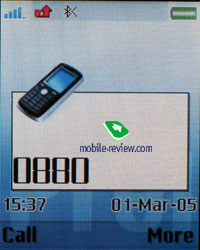 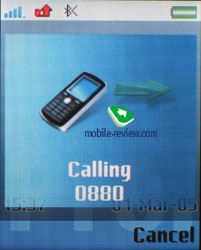
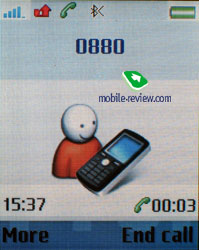 
 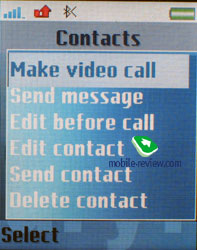
 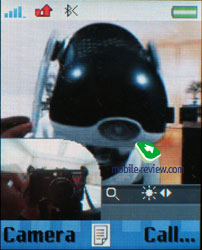
The device seems to remind the K700 in hardware at first sight, the same memory capacity, the same interface used. But really the model is closer to Sony Ericsson K750; consider the radio with RDS, new functions, for instance, VideoDJ and so on. A USB cable included into the kit allows address the device memory directly from a PC using it for transporting files.
Missed calls, received messages indication shown on the black background in the standby mode is a pleasant peculiarity. In contrast to Nokia's phones, it's hard to miss them due to the giant size.

The quality of the camera is poor, but the model is not positioned a photo solution. Mainly the camera is a дань моде, a necessary addition. In the countries without 3G networks the model will be interesting only to those who liked the design, dislike the K700 for some reasons and need this very functionality. And with the appearance of 3G networks the model will be really popular. The device joins small size, good functionality and proved n the GSM market solutions. We can surely say, the K600 will be a bestseller in its class having no direct or strong rivals at the moment. Also one should understand, the device is not made as the most functional and that is why memory cards are absent. The model mainly belongs to the middle class and is to become one of the most popular shortly.
The launch should be expected in the end of September, the price will form about 450 USD in retail, not operator, network. The device will also appear on the markets where big operators are present as well as 3G networks. I will take a risk and suppose soon we'll see the model in another colour solution for one of the European operators. Very probable the colour palette won't be limited with two variations and will be even wider. The price reserve of a model is high, the company is ready to decrease the price to the level of 250-275 USD if necessary and high competition is present.
Eldar Murtazin (eldar@mobile-review.com)
Translated by Maria Mitina (maria.mitina@mobile-review.com)
Published — 20 March 2005
Have something to add?! Write us... eldar@mobile-review.com
|
































































































